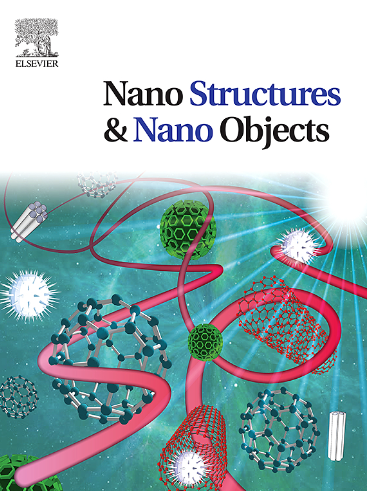Green synthesis of ZnO nanoparticles using Citrullus lanatus fruit extract and their potential for microwave absorption
IF 5.45
Q1 Physics and Astronomy
引用次数: 0
Abstract
Nanotechnology is a developing arena of science focuses on the manufacturing use of nanoparticles (NPs), of the size ranges between 1 and 100 nm, which are categorized into different classes such as inorganic, organic, ceramic and carbon-based nanoparticles. Zinc Oxide (ZnO) nanoparticles (NPs) are perceiving amazing progress during the past few periods due to its exclusive and vital properties in many applications. Newly, green synthesis method of NPs is competing in contradiction of traditional chemical and physical methods by avoiding the use of many toxic compounds, and costly equipment. Accordingly, in this study, watermelon (Citrullus lanatus) rind extract has been used for producing ZnO NPs as a reducing, capping and stabilizing agents. This technic is simple, environmentally friendly and green. UV–vis spectra indicated the formation of Zinc Oxide nanoparticles represented by the change of a colorless liquid to brownish solution. The involvement of the functional groups presents in (Citrullus lanatus) rind extract in both the reduction and capping of nanoparticles was shown through Fourier transform infrared spectroscopy (FTIR). Additionally, the mechanism of formation ZnO NPs from (Citrullus lanatus) rind extract has been thoroughly delineated. This study displayed that (Citrullus lanatus) rind extract is a suitable medium for manufacturing spherical, monodisperse, highly crystalline and wide band gap ZnO NPs. This study emphasizes the potential of ZnO thin films as a promising material for microwave absorption applications, particularly for coating microwave oven gates. It also paves the way for using sustainable resources to develop high-performance materials capable of absorbing unwanted microwave radiation.
西瓜果实提取物绿色合成纳米氧化锌及其微波吸收潜力
纳米技术是一个发展中的科学领域,其重点是制造纳米颗粒(NPs),其尺寸范围在1到100 纳米之间,可分为不同的类别,如无机、有机、陶瓷和碳基纳米颗粒。氧化锌纳米颗粒(ZnO nanoparticles, NPs)由于其独特而重要的特性在许多领域的应用,在过去的几年中取得了惊人的进展。新型纳米粒子的绿色合成方法由于避免了许多有毒化合物的使用和昂贵的设备,正在与传统的化学和物理合成方法相竞争。因此,本研究以西瓜(Citrullus lanatus)皮提取物为还原剂、封盖剂和稳定剂制备氧化锌NPs。该技术简单、环保、绿色。紫外可见光谱显示氧化锌纳米颗粒的形成由无色液体变为褐色溶液。傅里叶变换红外光谱(FTIR)研究了柑桔皮提取物中官能团参与纳米粒子还原和封盖的过程。此外,还对柑桔皮提取物形成氧化锌NPs的机理进行了较为全面的研究。研究表明,瓜皮提取物是制备球形、单分散、高结晶、宽禁带ZnO纳米粒子的理想介质。这项研究强调了ZnO薄膜作为一种有前途的微波吸收材料的潜力,特别是在微波炉门的涂层上。它还为利用可持续资源开发能够吸收不必要微波辐射的高性能材料铺平了道路。
本文章由计算机程序翻译,如有差异,请以英文原文为准。
求助全文
约1分钟内获得全文
求助全文
来源期刊

Nano-Structures & Nano-Objects
Physics and Astronomy-Condensed Matter Physics
CiteScore
9.20
自引率
0.00%
发文量
60
审稿时长
22 days
期刊介绍:
Nano-Structures & Nano-Objects is a new journal devoted to all aspects of the synthesis and the properties of this new flourishing domain. The journal is devoted to novel architectures at the nano-level with an emphasis on new synthesis and characterization methods. The journal is focused on the objects rather than on their applications. However, the research for new applications of original nano-structures & nano-objects in various fields such as nano-electronics, energy conversion, catalysis, drug delivery and nano-medicine is also welcome. The scope of Nano-Structures & Nano-Objects involves: -Metal and alloy nanoparticles with complex nanostructures such as shape control, core-shell and dumbells -Oxide nanoparticles and nanostructures, with complex oxide/metal, oxide/surface and oxide /organic interfaces -Inorganic semi-conducting nanoparticles (quantum dots) with an emphasis on new phases, structures, shapes and complexity -Nanostructures involving molecular inorganic species such as nanoparticles of coordination compounds, molecular magnets, spin transition nanoparticles etc. or organic nano-objects, in particular for molecular electronics -Nanostructured materials such as nano-MOFs and nano-zeolites -Hetero-junctions between molecules and nano-objects, between different nano-objects & nanostructures or between nano-objects & nanostructures and surfaces -Methods of characterization specific of the nano size or adapted for the nano size such as X-ray and neutron scattering, light scattering, NMR, Raman, Plasmonics, near field microscopies, various TEM and SEM techniques, magnetic studies, etc .
 求助内容:
求助内容: 应助结果提醒方式:
应助结果提醒方式:


